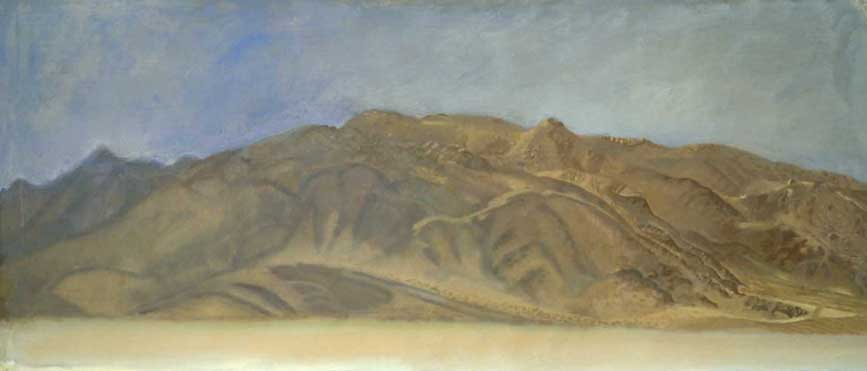 |
|
Queen
Mountain, 1998, 54
x 48, oil on canvas, private collection
|
The Mojave Desert exerts the tangible potency of a lucid dream. Vast as an ocean - the desert is really just an ocean that's matured beyond the liquid state - exotic as an oriental bazaar and so hauntingly complex that it would take a lifetime to explore, the Mojave seduces the psyche. Along its elegant gold horizons, John the Baptist forages among the snakeweed and cholla, preparing the way for some messiah or other. Next to its stark majesty, forests and fields appear overwrought, a little silly. The desert needs no adornment. Wearing a sky lavish with shooting stars and carpeted by the craftiest botanicals, the desert defies us to find comfort within its mineral heart.
The morning temperatures accelarate past the 90 degree mark and continued on to burn 115 degree holes in my brain. Such intensity. Such heart-stopping beauty. Be patient and the intricate details will emerge, details often lost in more temperate, water-rich regions. Shadows contract and expand with the hunting slender snakes and lizards of no particular color, yet always the exact color of the shifting sand. A tinder-dry thatch of apache plume forms a shady forest for a chipmonk. Coyotes lounge in the larger shade of tamarisk trees, soothing grey green against the glittering rocks. Mirages mambo crazily in the distance across mountain ranges whose subtle colors acquire increasing density and hue as your eyes grow accustomed to a world without leaves and grass. Sagebrush and mesquite - stately, evenly spaced groves of mesquite - echo the locations of broad root systems. One imagines an underground conversation, of roots whispering in the cool dark away from the merciless heat. As your eyes acquire a new, more subtle set of calibrations, the true desert begins to appear. The mountains unmistakably display the very backbone of the continent. The vast sweeps of alluvial fans suggest millenia of rains that moved raspberry iron oxides, turquoise copper deposits and yellow bands of sulfur and chloride from mountain tops down to soft valley floors. Here in these million undeveloped acres, the desert reveals itself still at play - a mardi gras of crystals and rust. You can read by moonlight - here at the western edge of the Mojave, where big-horned mountain sheep climb the big rocks and coyotes sing their dreams. This is the way into the mystic.
 |
| Joshua Tree National Monument, 1999, oil on canvas, 32 x 63" |
What looks from a distance like so much wasteland is transformed, on closer inspection, into an intricate pattern of washes and canyons bearing surprising juiciness and a wealth of animal tracks. After one spring rain, a sudden colonization of flowers grips the dusty corridors of myriad arroyo. The rocks each beg forinspection, some bearing the green ofcopper, others glittering with mica and pyrite. The blood-red Martian rocks are the volcanic debris from the Mojave's many fairly recent eruptions - most notably at saucy little Amboy Crater, just two hours along old Route 66 from Barstow. By day, long-eared jackrabbits pant in the creosote. A lone road runner patrols madly, while huge black ravens circle the oasis. The hum of insects echoes the throb of the desert floor, vibrating in the heat - everything suspended in an arid freeze frame until the hour before sunset when life can continue. The mountains that hug the southern edge of the oasis of Mara lie within the mighty Joshua Tree National Monument, an hallucinogenic jumble of boulders the size of office buildings where every Western movie you ever saw as a kid was filmed. When we pay our respects to these 850,000 sacred acres we rise before dawn, walk or drive to any one of a million panoramic spots - like the enchanted trail to 49 Palms Canyon - and wait for the sun. Deep purples shape-shift into magenta and then orange - barrel cacti glow red in the gathering day - the rocks reveal their secret identities as living creatures tuned to a mineral, rather than biological, genetic code. Once the sun is up, the spell is broken - until sunset.The desert is addictive, a sere warp of both time and space. ©C.Waters
©Frank Galuszka 2009